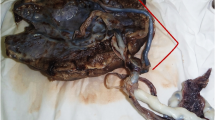Abstract
Neonaticide is a serious allegation that needs a complete chain of criminal investigations. In this context, a nuchal cord is considered to be responsible for an infant’s death, but there is a clear lack of evidence. The purpose of our study is to reveal if a nuchal cord can be responsible for stillbirth, poor perinatal outcome, or neonatal death in the forensic aspect. We conducted a prospective study in collaboration with the Augustinian Sisters’ Hospital in Cologne, Germany in the period from February 2014 to May 2016. Four-hundred eighty-six children were enrolled. All births were assessed regarding the occurrence of an umbilical cord entanglement, and perinatal outcome was measured by arterial blood gas analysis, Apgar after 1, 5, and 10 min after birth as well as the general vitality. The prevalence of a nuchal cord was 16.87%. Apgar decrease and acidosis were significantly associated with a nuchal cord. No adverse perinatal outcome was recorded in this constellation. There was no child death regarding the first 24 h, and no mother experienced a syncope while giving birth. We can conclude that a nuchal cord is not associated with adverse perinatal outcome.



Similar content being viewed by others
References
United Nations (1989) General, A., Convention on the Rights of the Child, 20 November 1989. Annu Rev Popul Law 16(95):485–501
Willinger M, James LS, Catz C (1991) Defining the sudden infant death syndrome (SIDS): deliberations of an expert panel convened by the National Institute of Child Health and Human Development. Pediatr Pathol 11(5):677–684. https://doi.org/10.3109/15513819109065465
Mack-Detlefsen B, Banaschak S, Boemers TM (2015) Traumatic vulvar epithelial inclusion cysts following female genital mutilation (FGM). Geburtshilfe Frauenheilkd 75(9):945–948. https://doi.org/10.1055/s-0035-1557862
Resnick PJ (1970) Murder of the newborn: a psychiatric review of neonaticide. Am J Psychiatry 126(10):1414–1420. https://doi.org/10.1176/ajp.126.10.1414
Friedman SH, Resnick PJ (2009) Neonaticide: phenomenology and considerations for prevention. In: Int J law psychiatry, pp 43–47
Schulte B, Rothschild MA, Vennemann M, Banaschak S (2013) Examination of (suspected) neonaticides in Germany: a critical report on a comparative study. Int J Legal Med 127(3):621–625. https://doi.org/10.1007/s00414-013-0841-8
Tursz A, Cook JM (2011) A population-based survey of neonaticides using judicial data. Arch Dis Child Fetal Neonatal Ed 96(4):F259–F263. https://doi.org/10.1136/adc.2010.192278
Herman-Giddens ME, Smith JB, Mittal M, Carlson M, Butts JD (2003) Newborns killed or left to die by a parent: a population-based study. JAMA 289(11):1425–1429. https://doi.org/10.1001/jama.289.11.1425
Nordrhein-Westfalen L (2015) Neonatizid. Die Tötung von Neugeborenen. Düsseldorf, Landeskriminalamt NRW
Collins JH (1997) Nuchal cord type a and type B. Am J Obstet Gynecol 177(1):94. https://doi.org/10.1016/S0002-9378(97)70444-7
Kong CW, Lee DH, Chan LW, W.W. To (2015) Impact of nuchal cord on fetal outcomes, mode of delivery, and management: a questionnaire survey of pregnant women. Hong Kong Med J 21(2):143–148. 10.12809/hkmj144349
Casper JL (1871)Practisches Handbuch der gerichtlichen Medizin. Hirschwald Verlag Berlin
Miura N, Suzuki S (2008) Fetal asphyxia due to cord entanglement in a monochorionic diamniotic twin pregnancy complicated by 2nd-trimester single intrauterine demise. Fetal Diagn Ther 23(1):69–71. https://doi.org/10.1159/000109229
Iffy L, Varadi V (1994) Cerebral palsy following cutting of the nuchal cord before delivery. Med Law 13(3–4):323–330
Madea B (2007) Basiswissen Rechtsmedizin. Springer-Verlag, Berlin
Sheiner E, Abramowicz JS, Levy A, Silberstein T, Mazor M, Hershkovitz R (2006) Nuchal cord is not associated with adverse perinatal outcome. Arch Gynecol Obstet 274(2):81–83. https://doi.org/10.1007/s00404-005-0110-2
Kong CW, Chan LW, W.W. To (2015) Neonatal outcome and mode of delivery in the presence of nuchal cord loops: implications on patient counselling and the mode of delivery. Arch Gynecol Obstet 292(2):283–289. https://doi.org/10.1007/s00404-015-3630-4
Sornes T (2000) Umbilical cord knots. Acta Obstet Gynecol Scand 79(3):157–159. https://doi.org/10.1080/j.1600-0412.2000.079003157.x
Airas U, Heinonen S (2001) The clinical significance of umbilical knot in obstetrics. Duodecim 117(22):2273–2277
Buyukkayaci Duman N, Topuz S, Bostanci MO, Gorkem U, Yuksel Kocak D, Togrul C, Gungor T (2017) The effects of umbilical cord entanglement upon labor management and fetal health: retrospective case control study. J Matern Fetal Neonatal Med:1–5. https://doi.org/10.1080/14767058.2017.1293033
Kobayashi N, Aoki S, Oba MS, Takahashi T, Hirahara F (2015) Effect of umbilical cord entanglement and position on pregnancy outcomes. Obstet Gynecol Int 2015:342065. https://doi.org/10.1155/2015/342065
Ogueh O, Al-Tarkait A, Vallerand D, Rouah F, Morin L, Benjamin A, Usher RH (2006) Obstetrical factors related to nuchal cord. Acta Obstet Gynecol Scand 85(7):810–814. https://doi.org/10.1080/00016340500345428
Assimakopoulos E, Zafrakas M, Garmiris P, Goulis DG, Athanasiadis AP, Dragoumis K, Bontis J (2005) Nuchal cord detected by ultrasound at term is associated with mode of delivery and perinatal outcome. Eur J Obstet Gynecol Reprod Biol 123(2):188–192. https://doi.org/10.1016/j.ejogrb.2005.02.026
Mastrobattista JM, Hollier LM, Yeomans ER, Ramin SM, Day MC, Sosa A, Gilstrap LC 3rd (2005) Effects of nuchal cord on birthweight and immediate neonatal outcomes. Am J Perinatol 22(2):83–85. https://doi.org/10.1055/s-2005-837737
Ghosh GS, Gudmundsson S (2008) Nuchal cord in post-term pregnancy - relationship to suspected intrapartum fetal distress indicating operative intervention. J Perinat Med 36(2):142–144. https://doi.org/10.1515/JPM.2008.012
Miser WF (1992) Outcome of infants born with nuchal cords. J Fam Pract 34(4):441–445
Schaffer L, Burkhardt T, Zimmermann R, Kurmanavicius J (2005) Nuchal cords in term and postterm deliveries--do we need to know? Obstet Gynecol 106(1):23–28. https://doi.org/10.1097/01.AOG.0000165322.42051.0f
Clapp JF 3rd (1999) B. Lopez and S. Simonean, nuchal cord and neurodevelopmental performance at 1 year. J Soc Gynecol Investig 6(5):268–272
Larson JD, Rayburn WF, Crosby S, Thurnau GR (1995) Multiple nuchal cord entanglements and intrapartum complications. Am J Obstet Gynecol 173(4):1228–1231. https://doi.org/10.1016/0002-9378(95)91359-9
Carey JC, Rayburn WF (2000) Nuchal cord encirclements and risk of stillbirth. Int J Gynaecol Obstet 69(2):173–174. https://doi.org/10.1016/S0020-7292(99)00219-2
Freyer M (1887) Die Ohnmacht bei der Geburt vom gerichtsärztlichen Standpunkt. https://doi.org/10.1007/978-3-642-91565-9
Rodriguez-Manero M, Casado-Arroyo R, Sarkozy A, Leysen E, Sieira JA, Namdar M, Conte G, Levinstein M, Chierchia GB, de Asmundis C, Brugada P (2014) The clinical significance of pregnancy in Brugada syndrome. Rev Esp Cardiol (Engl Ed) 67(3):176–180. https://doi.org/10.1016/j.rec.2013.06.023
Author information
Authors and Affiliations
Corresponding author
Rights and permissions
About this article
Cite this article
Walla, T., Rothschild, M.A., Schmolling, J.C. et al. Umbilical cord entanglement’s frequency and its impact on the newborn. Int J Legal Med 132, 747–752 (2018). https://doi.org/10.1007/s00414-017-1746-8
Received:
Accepted:
Published:
Issue Date:
DOI: https://doi.org/10.1007/s00414-017-1746-8




